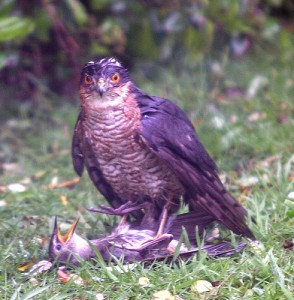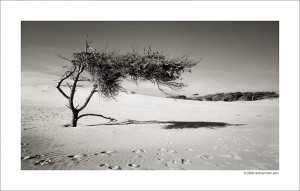The more I read Darwin’s Origin of the Species, the more I am amazed at how his work opens the mind to so many different perspectives on human nature, human society, human evolution and the environments we use to develop relationships. This is a man who had and still has a singularly unique perspective on the design of nature.
One of the more fascinating pieces of his work was how he viewed what he deems the struggle for existence, including “the dependence of one being on another, and including not only the life of the individual, but the success in leaving progeny”.
But how is this even remotely related to Social Media or farther still Large Enterprise in Social Media?
Well, try this out and see if you agree…
First, think of Social Media Environments like a living, breathing, ever changing ecosystem where millions of beings (of all shapes, sizes, and dispositions) co-exist and contribute to the ecosystem by consuming and creating food. Add to this another layer I’ll refer to as the food layer which is made of of ideas and conversations.
Second, let’s say that all beings within social media environments are dependent on one another; why else would we need followers? And that their progeny is their ideas and/or their brand; thus the need to attract followers who take on your idea and brand – metaphorically they become your offspring.
Here is where I’m going to throw a bit more Darwin at you.
“We behold the face of nature (read Social Media) bright with gladness, we often see superabundance of food (read ideas and opportunities); we do not see, or we forget, that the birds which are idly singing round us mostly live on insects or seeds and are constantly destroying life; or we forget how largely these songsters, or their eggs, or their nestlings, are destroyed by birds and beasts of prey; we do not always bear in mind, that though food may be now superabundant, it is not so at all seasons of each recurring year.” – Charles Darwin
If we step out of our deeply rooted perspective of ourselves, our business, and our customers we can begin to see how his observations, even natural laws, begin to become relevant to a virtual ecosystem like Twitter or FaceBook.
To illustrate this, let’s look at a couple ways the struggle for existence manifests itself within social media environments.
The struggle of ideas.
Do ideas destroy other ideas? Most certainly. An idea flourishes depending on its strength, relevancy, value and on the beings that promote them. The stronger or more plentiful the beings, the greater chance for the idea to flourish and to create difficulty for competing ideas to flourish. So how many ideas can an ecosystem maintain? Hard to say, but certainly as one idea becomes dominant, another struggles for existence.
The struggle of companies and brands. 
Do companies actually compete against other companies within social media environments or do they struggle to exist against the environment? Much like plants at the edge of a desert struggle for moisture; never competing against other plants, insects or animals, but simply for existence. I would imagine much of this is because brands (and the businesses behind them) are so new to the concept of such an environment. From Darwin’s perspective, they may just be the weakest beings within social media environments – possessing few traits that actually contribute to social survival, let alone social dominance.
The struggle of beings.
While all beings within social ecosystems are dependent on others, the struggle between them is relentless. Gurus, both real and fake, compete by churning out ideas, conversations and opinions that vie for relevancy with followers. Followers compete for attention from those they follow and for relevancy and standing within their social circles. Progeny are created and destroyed as they take up ideas or replace them with new, better ones that are more attractive to them personally or attractive to their social circle, thus improving their own standing and dominance.
The struggle of virtual ecosystems.
Looking at social ecosystems from the 30,000 foot level, we can see how even ecosystems struggle for existence. An ecosystem’s survival depends on creating an attractive environment for beings to flourish, with the ability to produce plentiful, high quality food. The more that ecosystem can evolve its attractive qualities, the more likely the chance it will flourish and dominate other virtual ecosystems. We see this in the struggle between the great social platforms of You Tube, Buzz, Twitter, FaceBook, and FourSquare even as we see the decay of MySpace.They can’t all dominate and the weaker ones will surely decay and cease to exist.
Does the struggle ever get easier?
Most certainly it does and in the same breath most certainly it does not. As both beings and brands evolve stronger, more socially dominant traits, they will have an easier time attracting followers and keeping them within these social media environments. Several things are clear though, the struggle for existence ensures balance by creating strong, adaptable beings (people, brands, and platforms) and winnows out the weaker versions of the same.
Agree? Disagree? Think I’m a lunatic? Let me know! I love the comments and debate.
Cheers!
Jeff – Sensei
[…] you believe, like I do, that ideas struggle for existence; rising and falling as they gain strength or weaken to competing ideas then this could be an […]
Pingback by The Great Influence Debate – What if Watts and Gladwell are both wrong and both right? - The Mountaintop — September 5, 2010 @ 7:24 am
[…] you believe, like I do, that ideas struggle for existence; rising and falling as they gain strength or weaken to competing ideas then this could be an […]
Pingback by The Great Influence Debate — September 11, 2010 @ 2:11 pm
[…] It is the company that invests in the social relationship, not the social media channel, that will achieve long term success. Its what i refer to as a socially dominant brand trait. More here on the struggle for existence and social traits. […]
Pingback by Embracing Social Change in 2011 | THE SOCIAL CMO Blog — January 12, 2011 @ 6:22 pm